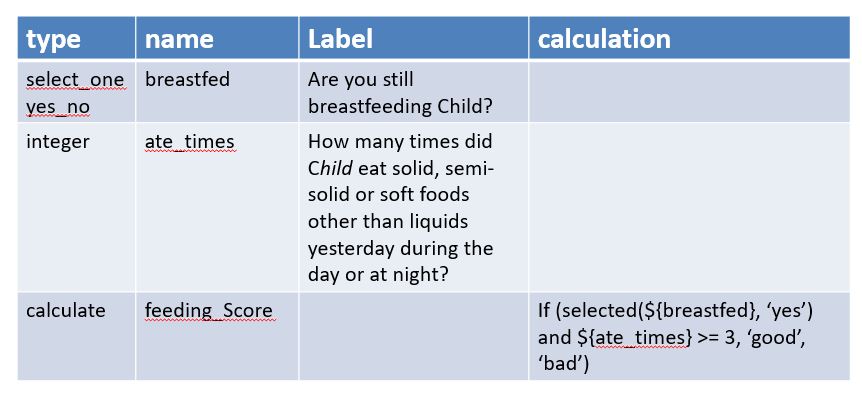Calculations
Introduction
Sometimes you need to calculate a value and its handy to store that somewhere
For use in a relevance or constraint
To show the enumerator a derived value
Sometimes you may just want a calculated value to use in your analysis and doing the calculation on the phone is just a good place to get this done
You need to:
Specify the question type as "calculate"
Provide a unique name
Specify the calculation in the calculation column
Calculations use Expressions extensively and you should familiarise yourself with the reference material if you are going to use them.
Example - Age in Months from date of birth
The expression to put in the calculation column is:
round(((today()-${dob}) div 30.4), 1)
Breaking this down:
All dates store their answers as a count of days since the 1st of January 1970.
The today() function returns the current date.
Hence if we subtract the answer to the dob question from today's date we get the number of days since the child was born.
We put (today()-${dob}) in brackets because we want it calculated first. Then we divide by 30.4. This converts the number of days into roughly the number of months. Not calendar months but in many cases the more useful value of a number of months.
This gives us the child age in months but if we display this to the user it is likely to have a large number of digits after the decimal place. So to pretty this up we use the round() function.
The round function takes 2 parameters. round(value, number of places). In our example we have specified the number of places after the decimal point as 1.
We could then show the calculation to the enumerator or use it in a relevance such as:
${age_months} < 60

Age in Months Calculation
Example - Age in Years from date of birth

Age in Years Calculation
The if() function
One function deserves special mention because it is so useful. We may want to convert the answers to a number of questions into a simple score that we can use in relevance to determine further questions or to determine services that should be provided.
For example the requirement might be:
If a child is still breast feeding and the child eats solids more than 3 times per day then the feeding
score is "good" else it is "bad".
The implementation with an if() function would then look like this:
if(condition, true response, false response)
The condition is: selected(${breastfed}, 'yes') and ${ate_Times} >= 3
If this is true we want the calculation result to be "good"
However if it is false then we want the calculation result to be "bad"
Putting it all together results in the following calculation

If() Calculation
Nested if() functions
Often we will want to nest if() functions one inside the other in order to generate a scale.
It looks like this:
if(condition1, value1, if(condition2, value2, value3))
So if condition1 is true the answer for the calculate will be value1.
Otherwise we move on to the next if() function
if condition2 is then true the answer will be value2
Otherwise the answer will be value3
Hunger Scale example
To get the data we ask three questions of type select_one
Question (a) In the past four weeks was there ever a time when there was no food to eat of any kind in your household because of lack of resources to get food?
Question (b) In the past four weeks, did you or any household member go to sleep at night hungry because there was not enough food?
Question (c) In the past four weeks, did you or any household member go a whole day and night without eating anything because there was not enough food?
The answer to each of these questions is a number between 0 and 2
rarely (once or twice in the past four weeks)
sometimes (three to ten times in the past four weeks)
often (more than ten times in the past four weeks)
We are going to add all of these up and if the total is
0 - 1 then the answer is "little to no hunger"
2 - 3 "moderate household hunger"
4 - 6 "severe household hunger"
To make the calculation easier to read we can do it in 2 stages. First we calculate the total (hunger_score) and then we convert that into the hunger scale as shown below:

Hunger Score Calculation
Dynamic Text Calculation
Text functions can be used to dynamically create guidance text that includes formatting:
calculate hunger_msg concat('The hunger scale is <font color="blue">', ${hunger_scale}, '</font>')
Triggering the Calculation
Requires Smap Server 21.01 or above.
By default calculations are triggered whenever any of the questions that they refer to change. They are also re-calculated when the survey is saved. You can use the once() function to change this behaviour and only calculate the value a single time. Also you can use the default() function wrapped around the calculation to prevent it from being re-calculated on save of the survey. (details here)
You can also specify a specific question that will trigger the calculation when it changes. This way you can update the value of a calculation by answering a question that does not appear in the actual calculation.
This approach works like using the default() option in that the calculation will not be re-evaluated on save and hence any updates the user has made will be preserved.
XLSForm that calculates the time at which a question answer was changed
type |
name |
label |
calculation |
trigger |
|---|---|---|---|---|
text |
name |
Name |
||
dateTime |
name_entered_time |
Started section at: |
now() |
${name} |